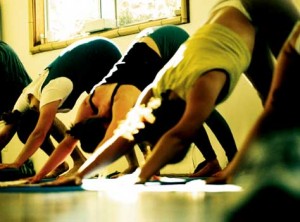During this hectic time of year your yoga practice is especially helpful in reducing anxiety, but if you cannot fit in a full yoga class, practicing on your own is second best. Restorative poses like forward bends top the list to release stress and refresh the mind and body, but it is important that they are done correctly.
The following principles are categorized by body part and action to help you practice safe and effective restorative forward bending yoga poses.
Imagine your pelvis as a bowl of water and your spine as the stream of water that spills from the bowl. By placing both hands on your hips and tipping your hips forward first as if to pour the water onto your feet, you set the forward bend up from your hips rather than from your lower back. This prevents the action of lumbar lordosis (rounding out) from your lumbar spine, which can stress the discs of the lower back.
Knees
If your hamstrings are tight, simply bend your knees. This will allow your pelvis to tip forward with ease without rounding your lower back. Also, you can bend your knees if you feel tension behind them and if you feel a tugging sensation on your sitting bones. It is best to feel the stretch in the belly of the muscle, rather than at the attachment points (sit bones and backs of knees). This helps to protect your tendons and ligaments from excess strain.
Lower back
In a perfect forward bend, the body is shaped like a bobby pin with the fulcrum of the curve at the hips. If striving to look like a bobby pin has you bending from your lower back, you will soon fatigue and possibly injure yourself. Instead, bend your knees and rock your pelvis forward to allow your spine to lengthen out from the hips. This applies in all forward bending poses, whether you are sitting, standing or inverted.
Balance
Often times we tend to lean back into our heels while in a standing forward bend and this can lead to misalignment problems in the hips and knees. In order to avoid this, shift your balance toward the balls of your feet. This will require a bit more muscle energy in your legs, preventing you from overstretching your hamstrings or injuring your joints.
Breath
Practicing yoga without any regard to your breath is like eating nutrient-starved, empty calories. To gain the full benefits of yoga you must be cognizant of the depth and rhythm of your breath. This is important because the breath is the connecting point between the body and the mind and that connection is the whole point of your practice. Without it you are just going through the motions and may miss out on those subtle yet magical insights your yoga practice can provide.
Also Read:

